日本平泉:代表佛教淨土的世界遺產
- 2017年 3月 2日
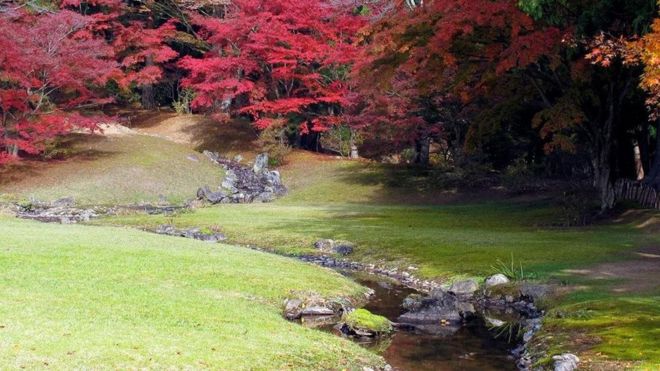 BETH REIBER
BETH REIBER
武士時代,封建制度下的日本彷彿在上演現實版《權力的遊戲》,有無數故事關乎家族背叛與復仇、政治陰謀與權術以及帝國之興衰。
這正是藤原清衡尤為受人敬仰的原因。1056年至1128年,他住在日本東北地區。儘管因為背叛,藤原失去了父親、妻子和一個孩子,但他決心打破流血殺戮的循環,用自己的巨額財富停止戰爭,換取和平。
 ALAMY
ALAMY
他選擇在平泉來建造這片極樂淨土,傾盡人生最後幾十年時間,建成世界上的一個佛教聖地。在這裏,無論人類還是動物,無論是敵是友,所有的靈魂都可以尋求慰藉,和諧共處。藤原清衡的兒子和孫子在其願景中建造了更多園林、寺廟和寶塔,將平泉的名聲傳遍了整個日本,甚至遠揚到中國。
不幸的是,故事到這裏就結束了。
1189年,在歷經藤原家族僅僅100年的三代和平統治後,好戰的源賴朝為了成為幕府大將軍並在鐮倉(距離今天的東京很近的一個城鎮)建立軍事獨裁,成功地征服並毀掉了這片佛教淨土。
在接下來的幾個世紀中,由於疏於修繕,再加上火災的發生,平泉宏偉壯觀的木製建築遭到了破壞。但是,藤原家族的成就極大地影響了日本的歷史,在人們的想像之中從未式微。鍍有金箔的金色堂,是自12世紀以來唯一完整保存下來的建築,被認為是日本最重要的建築之一,與你可在京都見到的所有建築不相上下。事實上,平泉可能是你未曾耳聞過的日本村莊中最重要的一個。
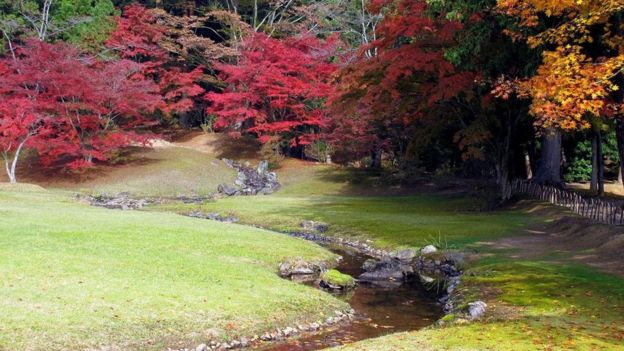 BETH REIBER
BETH REIBER
2011年,我第一次來到平泉,是在那場地震和海嘯發生之後的6個月後。地震和海嘯席捲了這個地區的沿海村莊,並帶走了超過19000人的生命。從仙台機場一路走來,路邊盡是大堆大堆的殘骸碎片,但是平泉的氛圍沒有受到什麼破壞,還是充滿希望。日本東北地區的旅遊業可能已經一落千丈,但是這座村莊已被聯合國教科文組織列入世界文化遺產名錄。
這座有著8000名居民的小村莊很是低調,又頗為整潔,只有很少的旅店,幾乎看不到那種把日本其他有名的旅行地搞得俗氣的紀念品商店。這裏小得很,你可以步行,可以騎車,也可以跳上環形觀光巴士到達大多數景點。但是,如果你匆匆走完所有地方,就體會不到藤原清衡對這裏所寄予的平和與純淨,因為那些珍貴的細節保留著900年前平泉全盛時期的一些模樣,因此欣賞你所目睹的一切,唯一的方式就是想像它曾經的盛況,並讓這裏的精神氣質發揮它的魔力。
我的第一站是平泉文化遺產中心,在那裏我了解了平泉巨大的文化和歷史意義,也了解了那位設想出如此一片佛教極樂淨土的人物。藤原清衡的一生跌宕起伏,七歲那年父親被殺害,母親被迫嫁給殺死自己丈夫的人。他與一群死敵一起長大。若干年後,為了給自己被殺害的妻子和孩子報仇,清衡殺死了自己同母異父的兄弟。之後,他不再效忠於地方勢力,轉而效忠於皇室,勢力迅速崛起,成為奧州的最高統治者。奧州地處偏遠,盛產黃金,就是現在的東北地區。但是,無論什麼都無法撫平清衡的痛苦,他決定在塵世開闢一片佛教的淨土,以慰亡靈。
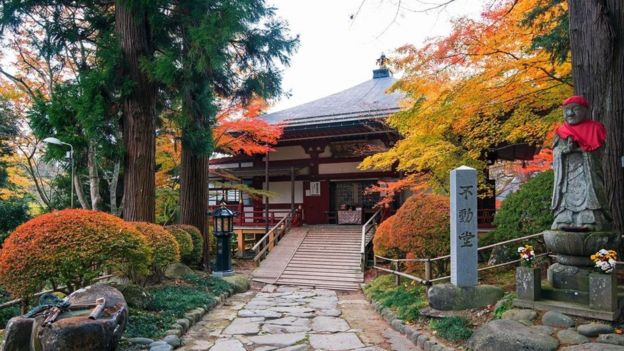 GETTY IMAGES
GETTY IMAGES
看到中尊寺,藤原清衡數不盡的宏偉成就也就立即出現在眼前了。這裏曾有超過40個大殿、寶塔和僧舍,可容納300位僧侶。現在,遊覽者們可以參觀主殿,體驗宗教儀式;可以參觀珍寶博物館,這裏陳列著超過3000件國寶和重要的文化遺產,包括佛像和藤原家族的明器;還可以觀看在露天茅草頂下的舞台上進行的傳統能劇表演,這樣的表演並不是隨時可以看到,只有在每年春秋的節日之際才會由中尊寺的僧侶和法師來表演。
但是至今唯一保存完好,和清衡在世時一樣的建築是令人嘆為觀止的金色堂(Konjikido),建成於1124年。一開始,我驚訝地發現這座金色堂完全被包裹在一座混凝土建築中,氣派和光芒都被剝奪殆盡。然而旋即我意識到,金色堂一直受人敬畏,自1288年起就一直被保護起來,避免受到自然力量的破壞。正是那一年,鐮倉幕府推翻了藤原家族的統治,建造起了金色堂的第一道保護網。
金色堂用紫檀木建成,周身幾乎都以金葉覆蓋,供奉著極樂世界的主佛阿彌陀佛,側面是侍者的塑像,還有象徵著極樂世界的孔雀浮雕和花朵。聖壇和四根柱子被銀飾、象牙、金屬、螺鈿以及摻了金粉的日本漆所覆蓋,細節極為精細,使得金色堂成為當時兼具藝術之美和建築之美的一大奇蹟。
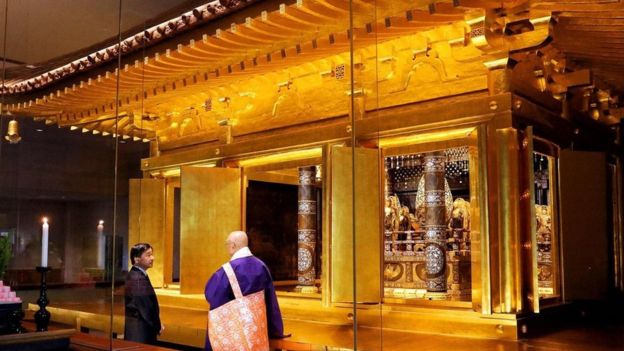 GETTY IMAGES
GETTY IMAGES
我的下一站是毛越寺,這座寺廟由清衡的兒子著手開始建造,由其孫建成,曾比中尊寺還要宏偉,有著能夠容納500位僧侶的僧舍,歷史的記載也曾宣告它在極樂淨土中佔有獨一無二的位置。唉,可惜如今只有石基尚存,不過有一幅巨大的插畫地圖描述了它曾經可能的模樣。
這裏,淨土庭園,也是我在平泉最喜歡的地方。這座庭園出乎意料地保存完好,被認為是12世紀以來最佳庭園的示例之一。中間有一大片池塘,旨在代表海洋,還有簡單的景觀美化的手法,如崎嶇的石壁、坐落的小山、蜿蜒的河灘、水中的島嶼,增添了視覺上的意趣。與日本其他傳統的精心設計的園林相比,這座院子顯然樸素自然、沒有矯飾,這正是我想像中一個撫慰人心的淨土樂園應該有的樣子。
就像面對日本大多數歷史遺跡時的心情一樣,我希望自己能夠得見平泉在其全盛時期的模樣。在平泉沒落了500年後,俳句詩人松尾芭蕉曾前來拜訪,想必他在寫下如下詩句時一定與我有相同的感受:
夏天草淒涼
功名昨日古戰場
一枕夢黃粱
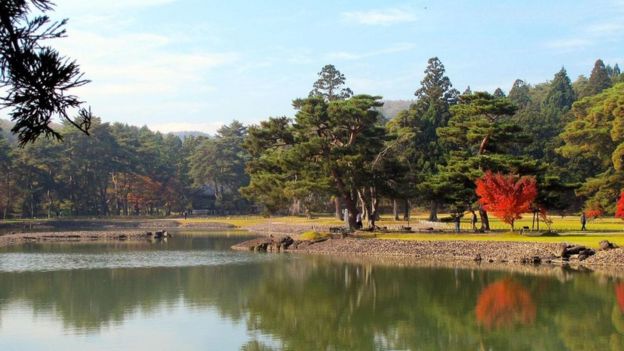 BETH REIBER
BETH REIBER
但是,這是一個好夢。而且令人驚奇的是,在金色堂的地基之中,安息著藤原清衡和他的兒子、孫子的乾屍,還有他的曾孫被砍下的頭顱,曾被源賴朝的支持者送去了鐮倉,作為藤原家族終結的證據。
所以,他們的遺骸連同他們的傳奇,被保存在這片佛教極樂淨土經過了幾個世紀後僅存的一座建築裏。如果這都不是因緣,那我不知道什麼才是因緣。
請訪問 BBC Travel 閲讀 英文原文。
http://www.bbc.com/travel/story/20170202-a-pure-land-inspired-by-treachery
Hiraizumi may well be the most important Japanese village you’ve never heard of.
During the days of the samurai, Feudal Japan was like Game of Thrones in real life, with countless tales of familial betrayal and revenge, political intrigue and empires won and lost.
That’s why Fujiwara no Kiyohira, who lived in Japan’s northeastern region of Tohoku from 1056 to 1128, is especially admirable. Despite losing his father, wife and a child due to treachery, Fujiwara decided to break the cycle of bloodshed and to use his immense wealth for peace rather than warfare.
Establishing headquarters in the village of Hiraizumi, he devoted the last decades of his life to creating a Buddhist heaven on Earth, where the souls of friends and enemies, both human and animal, could find consolation and live in harmony. His son and grandson added to Fujiwara's vision with even more gardens, temples and pagodas, spreading Hiraizumi’s reputation throughout Japan and as far away as China.
Sadly, that’s where the story ends.
In 1189, after only 100 years of peaceful reign under three Fujiwara generations, the Buddhist utopia was attacked by warlord Minamoto no Yoritomo in his successful quest to become shogun and establish his military dictatorship in Kamakura, a town not far from present-day Tokyo.
Over the ensuing centuries, neglect and fire ravaged Hiraizumi’s magnificent wooden buildings. Yet the accomplishments of the Fujiwaras were tremendously influential in Japanese history and never waned in the popular imagination. The heavily gilded Golden Hall, the only structure to have survived intact since the 12th Century, is considered one of Japan’s most significant buildings, on par with anything you might find in Kyoto. In fact, Hiraizumi may well be the most important Japanese village you’ve never heard of.
I first visited Hiraizumi in 2011, about six months after the earthquake and tsunami that obliterated coastal villages in the region and claimed more than 19,000 lives. Huge piles of debris lined the roads on my journey from Sendai Airport, but the mood in Hiraizumi, which suffered no damage, was hopeful. Tourism to Tohoku might have plummeted, but the village had just been recognized as a World Heritage site by Unesco.
The delightfully low-key, tidy town of some 8,000 residents has only a handful of accommodations and few of the tacky souvenir shops that plague Japan’s other celebrity destinations. It is small enough that you can walk, bike or hop on a circular tourist bus to most of its sights – but you won’t absorb Fujiwara's vision of peace and purity by zipping around in a hurry. That’s because precious little remains from Hiraizumi’s heyday all those 900 years ago, so the only way to appreciate what you see is by imagining how it was and letting the spirit of the place work its magic.
My first stop was the Hiraizumi Cultural Heritage Centre, where I learned about Hiraizumi’s vast cultural and historical significance and the man who envisioned the Buddhist Pure Land. Fujiwara's personal life is riveting, beginning at the age of seven when his father was executed and his mother was forced to marry into the family of her husband’s murderer. Fujiwara grew up among his mortal enemies, and, years later, after killing a half-brother in revenge for the death of his wife and child, he switched allegiance from regional to Imperial forces and rose as supreme ruler over a vast, remote region rich in gold called Oshu in what is now Tohoku. But when nothing assuaged his sorrow, Fujiwara decided to create a Buddhist paradise on Earth to console the souls of the dead.
His immense accomplishment is immediately apparent at Chuson-ji Temple, once home to more than 40 halls and pagodas and quarters for 300 monks. Today, visitors can explore the main hall for services and rituals; visit a treasure museum housing the temple’s more than 3,000 National Treasures and Important Cultural Properties, including Buddhist statues and burial objects belonging to the Fujiwara lords; and take in a rare, thatched-roof and open-air stage for traditional Noh performances, performed annually during spring and autumn festivals by Chuson-ji’s monks and priests.
But the only structure that remains as it was during Fujiwara's time is the stunning Golden Hall (Konjikido), completed in 1124. I was initially stunned to discover that the hall is entirely encased inside a concrete building, which severely detracts from its impact and brilliance. But then I learned that the Golden Hall is so revered that it has been protected from the elements ever since 1288, when the very Kamakura shogunate that had overthrown the Fujiwara family erected the hall’s first shelter.
Made of red sandalwood and covered almost entirely in gold leaf, the Golden Hall enshrines Amida, the principal Buddha of the Pure Land, flanked by statues of attendants and with reliefs of peacocks and flowers representing paradise. Silver, ivory, metalwork, mother-of-pearl inlay and Japanese lacquer sprinkled with powdered gold cover the altar and four columns in intricate detail, making the Golden Hall both an artistic and architectural marvel of its era.
My next stop was Motsu-ji Temple, established by Fujiwara's son and completed by his grandson. It was once even grander than Chuson-ji, with quarters for 500 monks; records from the time declared it unparalleled throughout the land. Alas, only stone foundations remain today, but a huge illustrated map depicts how it might have looked all those years ago.
Here, too, was my favourite place in Hiraizumi, the Pure Land Garden. Remarkably well preserved, and considered one of the finest garden examples from the12th Century, the garden centres on a large pond designed to represent an ocean, with simple landscaping techniques like craggy cliffs, mountains, a curved beach and islands providing visual interest. Starkly unadorned compared to Japan’s traditional landscaped gardens, it was just what I imagined a soothing Buddhist paradise might look like.
Like with most historic places in Japan, I wish I could have seen Hiraizumi at its zenith. Haiku poet Basho, who visited Hiraizumi 500 years after its fall, must have felt the same when he wrote:
The summer grass
‘Tis all that’s left
of ancient warrior’s dreams
But it was a great dream, and astoundingly, in the base of the Golden Hall, rest the mummified bodies of Fujiwara, his son and grandson, as well as the decapitated head of his great-grandson, which was sent to Kamakura by Minamoto sympathisers as proof of the Fujiwara demise.
And so their remains and legend are preserved in the only structure from the Buddhist Pure Land to have survived all those centuries. If that’s not karma, I don’t know what is.
沒有留言:
張貼留言